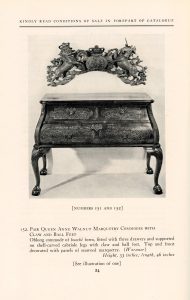Aside from Elaine’s modern bedroom, the Wormser’s apartment was decorated in styles referencing the past. Elaine recalled the apartment as featuring a mix of eighteenth-century English furnishings and “Grand Rapids-1910″ style—likely referring to the furniture produced in historical styles in Grand Rapids, Michigan, a nearby furniture manufacturing center. Linenfold paneling lined the living room walls, and paintings of Venice decorated the dining room. “My father had exquisite taste,” Elaine recalled. “He was one of the first people among our friends who bought English antiques.”
LISTEN: Elaine Wormser on the Wormsers’ Drake Tower apartment.
Transcript
But when we moved to the north side and this building was built, we had several decorators come in to discuss it, you know. And they were going to throw everything out, you know. Typical.
But most of it was Grand Rapids, 1910, you know…Tell you what else we had in our house that I wonder whatever happened to and I can’t think of [indistinct]. But we had Venetian scenes in our oil painted scenes, in our dining room. Mother and I had taken off the walls when we moved and we rolled up [indistinct]…My father had exquisite taste, well obviously, and he was one of the first people among our friends who bought English antiques and things of that kind. A lot of people had more French fancy stuff that I still don’t much like, you know…
– Elaine Wormser Reis interviewed by Anita Ellis, Otto Thiem, and Ellen Christenson, September 26, 1985. Curatorial file, Cincinnati Art Museum.


While it may seem odd that the Wormsers would commission such a modern bedroom for Elaine, it was not unusual for the time. Other cosmopolitan families, attuned to the rise of modernism evident in architecture, film, stage sets, shop windows, and museum exhibitions, tried out the new style in small, informal spaces like sitting rooms, dressing rooms, and bedrooms. Youthful and sophisticated, the modern style was enthusiastically embraced by, and marketed to, the younger generation.
